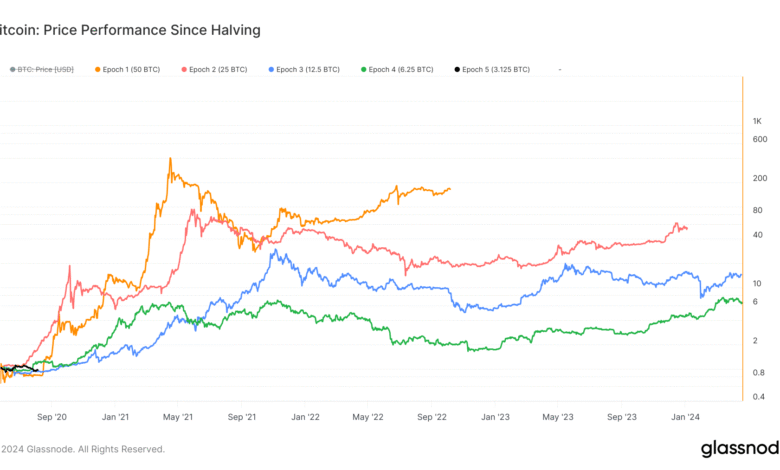Bitcoin Performance Dips After Jackson Hole Event

Bitcoin performance has taken a notable hit following the recent sell-off that occurred post-Jackson Hole, where a single wallet unloaded 24,000 BTC, triggering significant market chaos. This unexpected move resulted in a cascade of liquidations worth over $500 million, disrupting what seemed to be a promising rally for the leading cryptocurrency. Meanwhile, Ethereum price has been on the rise, buoyed by a shift in institutional investors’ appetite for digital assets. As Bitcoin dominance wanes, with a notable drop to 57%, market observers are keenly analyzing the dynamics affecting BTC sell-off cycles and the ETH market. The evolving landscape of cryptocurrency investments suggests a captivating tussle between Bitcoin and Ethereum, raising questions about future performance trajectories for both assets.
The recent fluctuations in Bitcoin’s market standing have prompted a thorough examination of its competitive performance against other cryptocurrencies, particularly Ethereum. Bitcoin’s unexpected decline after the Jackson Hole conference highlights the vulnerabilities of its current price structure, especially with significant wallet activities impacting the overall market. In contrast, Ether’s robust upward momentum, fueled by substantial institutional support, illustrates a shift in the investing zeitgeist among crypto portfolios. As they navigate the complexities of asset allocation, traders and analysts are increasingly probing the implications of BTC sell-offs and Ethereum’s ascendance within the digital currency landscape. This ongoing rivalry underscores the intricate relationship between market forces and investor behavior in a rapidly evolving crypto economy.
Understanding Bitcoin Performance Post-Jackson Hole
The aftermath of the Jackson Hole conference proved tumultuous for Bitcoin, which had initially enjoyed a brief rally following the event. However, this positive momentum was quickly curtailed by the significant sell-off of 24,000 BTC, resulting in a dramatic market reaction that erased $500 million in leveraged positions almost instantly. This incident illustrates the fragility of Bitcoin’s market structure, especially amidst an environment where institutional investors seem to be pulling back, contributing to the volatility observed in recent trading sessions.
Bitcoin’s struggle to maintain its prior rally emphasizes the impact of major holders liquidating significant amounts, which can quickly shift market sentiment. With a series of outflows from BTC spot ETFs amounting to approximately $1.2 billion over recent days, it is evident that the appetite for Bitcoin among institutional investors has waned. This situational downturn raises questions about sustainable growth for Bitcoin and whether it can regain the confidence required to restore its previous price levels.
Frequently Asked Questions
What caused the recent Bitcoin performance decline after the Jackson Hole conference?
The recent decline in Bitcoin performance can be attributed to a major sell-off, where a significant wallet dumped approximately 24,000 BTC into the market. This triggered a flash crash that wiped out around $500 million in leveraged positions, undermining the momentum generated during the Jackson Hole conference.
How did institutional investors react to the Bitcoin rally following the Jackson Hole event?
Following the Jackson Hole event, institutional investors have shown signs of waning support for Bitcoin, as evidenced by six consecutive sessions of outflows totaling around $1.2 billion from spot BTC ETFs. This shift in sentiment highlights a potential decline in institutional confidence in Bitcoin’s performance.
What impact did the Bitcoin sell-off have on the eth market?
The Bitcoin sell-off positively impacted the ETH market, leading to Ether outperforming Bitcoin as institutional interest shifted towards ETH. The ETH/BTC ratio climbed above 0.04, indicating a growing preference among traders for Ethereum over Bitcoin amid the recent market turmoil.
Will Bitcoin’s performance improve if institutional investors return?
If institutional investors return to support Bitcoin, it could significantly improve Bitcoin’s performance. Historically, increased institutional interest has stabilized BTC prices and driven growth, as seen during previous dips when institutions stepped in to purchase BTC.
What does the future hold for Bitcoin and Ethereum performance?
The future performance of both Bitcoin and Ethereum will likely depend on the strength of institutional flows and regulatory developments. Analysts suggest that while Bitcoin currently concedes momentum to ETH, a rebound in institutional interest could bolster Bitcoin’s performance in subsequent market cycles.
Why is the BTC sell-off significant for Bitcoin’s future performance?
The BTC sell-off is significant because it not only triggered immediate liquidation losses but also reflects a potential shift in market sentiment. Such sell-offs can lead to increased volatility and signify a cautionary tone among traders regarding Bitcoin’s future performance and stability.
How do Bitcoin and Ethereum compare in current market performance?
Currently, Ethereum is outpacing Bitcoin in market performance, especially after the recent sell-off in BTC. Ethereum has benefitted from increased institutional investment and demand, causing its price to rise significantly, while Bitcoin struggles to maintain its position in the market.
| Key Points | Details |
|---|---|
| Bitcoin’s Performance | Bitcoin’s post-Jackson Hole rally collapsed after 24,000 BTC were sold, leading to a $500 million liquidation. |
| Impact of Major Sell-Off | The sale triggered a flash crash and demonstrated decreasing institutional support for Bitcoin. |
| Institutional Flows | Spot BTC ETFs faced six sessions of outflows totaling around $1.2 billion, indicating reduced interest. |
| Ether’s Performance | Ether continued to rise, breaking the ETH/BTC ratio and achieving an all-time high of $4,957 before correcting. |
| Market Trends | Bitcoin’s market dominance dropped from 60% to 57% as traders favored Ether, particularly with potential ETF approvals. |
Summary
Bitcoin performance took a significant hit following a major sell-off, indicating a shift in market dynamics as Ether gains attention. The recent sell-off of 24,000 BTC has highlighted vulnerabilities in Bitcoin’s strength, overshadowing its momentary gains post-Jackson Hole. While institutional support appears to wane, Ether is thriving, driven by strong demand and a rotation of investments from Bitcoin to Ethereum. This development suggests that Bitcoin’s dominance may continue to be challenged moving forward.




